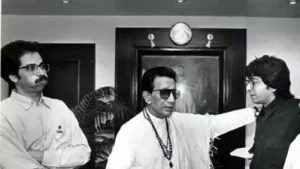The Maharashtra political landscape faces a seismic shift as the Thackeray alliance between cousins Uddhav and Raj Thackeray gains momentum ahead of crucial civic body elections. This unprecedented collaboration between the Shiv Sena (UBT) and Maharashtra Navnirman Sena (MNS) represents a strategic masterstroke targeting the Marathi-speaking electorate across major municipal corporations.
Sanjay Raut, a Shiv Sena (UBT) MP, confirmed the emerging Thackeray alliance, stating that both leaders would contest the upcoming civic polls together across Mumbai, Thane, Nashik, and Chhatrapati Sambhajinagar. This political reconciliation marks a dramatic departure from years of estrangement between the Thackeray cousins, potentially reshaping Maharashtra’s urban political dynamics.

Also Read: More on the Thackeray Alliance
For Additional information: Shiv Sena (UBT)
The Thackeray alliance carries profound strategic implications, particularly given that both parties draw support from identical demographic segments. Raj Thackeray’s political career has been characterised by frequent allegiance shifts, including recent meetings with Chief Minister Devendra Fadnavis and Mahayuti alliance leaders, sparking speculation about potential BJP collaboration.
However, the emerging Thackeray alliance represents a different trajectory. Both leaders recognise their shared voter base among the Marathi-speaking urban electorate, making collaboration more logical than competition. This unity could significantly disrupt existing political equations across Maharashtra’s municipal corporations.
The BJP has historically viewed Raj Thackeray as a strategic disruptor capable of fragmenting Uddhav’s core support base. However, the Thackeray alliance effectively neutralises this disruption strategy, consolidating Marathi votes under unified leadership.
The Maharashtra Navnirman Sena’s political journey provides crucial context for understanding the potential impact of the Thackeray alliance. During its inaugural municipal corporation contests between 2006-2009, MNS demonstrated significant influence despite limited resources.


In BMC specifically, MNS recorded 10.43% vote share, exceeding BJP’s performance and nearly matching NCP’s 11.29%. This early success demonstrated the party’s potential to influence crucial urban constituencies, validating the strategic logic behind the current Thackeray alliance.
The Thackeray alliance gains historical precedent from MNS’s peak performance during the 2009-2014 municipal elections. Contesting 24 of 26 corporations, MNS secured 162 seats with an impressive 12.43% overall vote share, establishing itself as a formidable urban political force.
MNS achieved remarkable success in Nashik, becoming the single-largest party with 40 seats and 28.24% vote share, successfully leading the corporation despite lacking an outright majority. The party also secured significant positions in Pune (29 seats), Brihanmumbai (28 seats), and Kalyan-Dombivli (27 seats).
This period highlighted MNS’s electoral complementarity with Shiv Sena. Analysis reveals that in seats won by MNS, Shiv Sena finished as runner-up in 56 instances, while in seats where MNS placed second, Shiv Sena won 92 positions. This pattern strongly supports the current Thackeray alliance strategy.
The most recent municipal elections (2014-2019) witnessed MNS’s dramatic decline, winning merely 26 seats across 21 corporations with 3.56% vote share. This precipitous fall raised serious questions about the party’s urban political relevance and sustainability.


The Thackeray alliance emerges as MNS’s recovery strategy, leveraging historical electoral complementarity with Shiv Sena (UBT) to regain lost ground. Combined vote banks could restore competitive positioning across major municipal corporations.
Both components of the Thackeray alliance draw support from identical demographic segments, particularly the urban Marathi-speaking electorate concentrated in Maharashtra’s major cities. This shared voter base has historically created competition between the cousins, fragmenting Marathi political influence.
Raj Thackeray’s regional identity politics resonates strongly with urban Marathi communities, while Uddhav’s leadership maintains traditional Shiv Sena loyalties. The Thackeray alliance consolidates these overlapping constituencies, potentially creating formidable electoral machinery.
Regional identity remains crucial for both leaders, with “Marathi Manoos” rhetoric forming the ideological foundation of their political appeal. The Thackeray alliance amplifies this messaging, presenting unified Marathi leadership against perceived external threats.
The Thackeray alliance represents calculated political pragmatism rather than mere familial reconciliation. Historical electoral data suggest strong complementarity between both parties’ performance, indicating potential synergistic benefits from collaboration.
Municipal corporation elections favour the Thackeray alliance due to local issues, where regional identity politics carry greater weight than state or national concerns. Urban Marathi voters often prioritise local representation and cultural preservation over broader political affiliations.
The success of the Thackeray alliance could establish precedents for future state and national election collaboration, potentially reshaping Maharashtra’s political landscape permanently. However, both leaders must navigate ideological differences and organisational challenges to maintain unity beyond immediate electoral objectives.
The emerging Thackeray alliance represents a watershed moment in Maharashtra politics, uniting previously competing Marathi political forces under shared leadership. Historical electoral analysis supports the strategic logic behind this collaboration, suggesting potential for significant political impact across municipal corporations.
Success depends on effective coordination, message discipline, and voter mobilisation capabilities. The Thackeray alliance must demonstrate tangible benefits to the Marathi-speaking electorate while maintaining organisational coherence across diverse urban constituencies throughout Maharashtra’s complex political environment.

